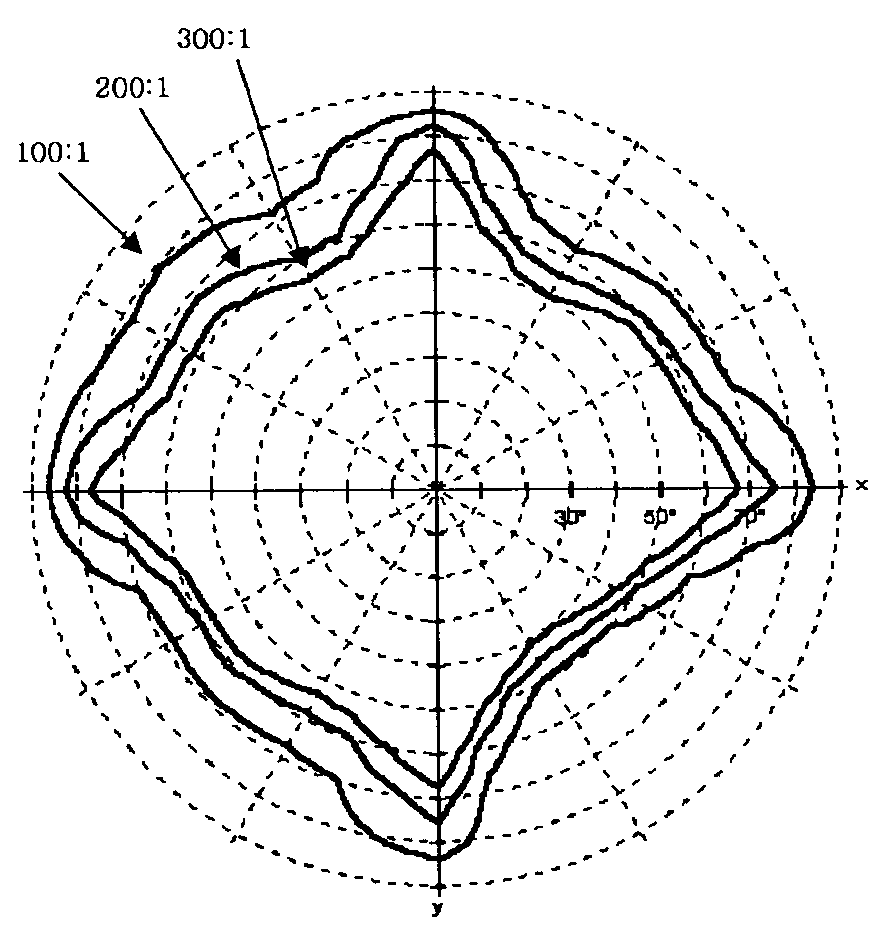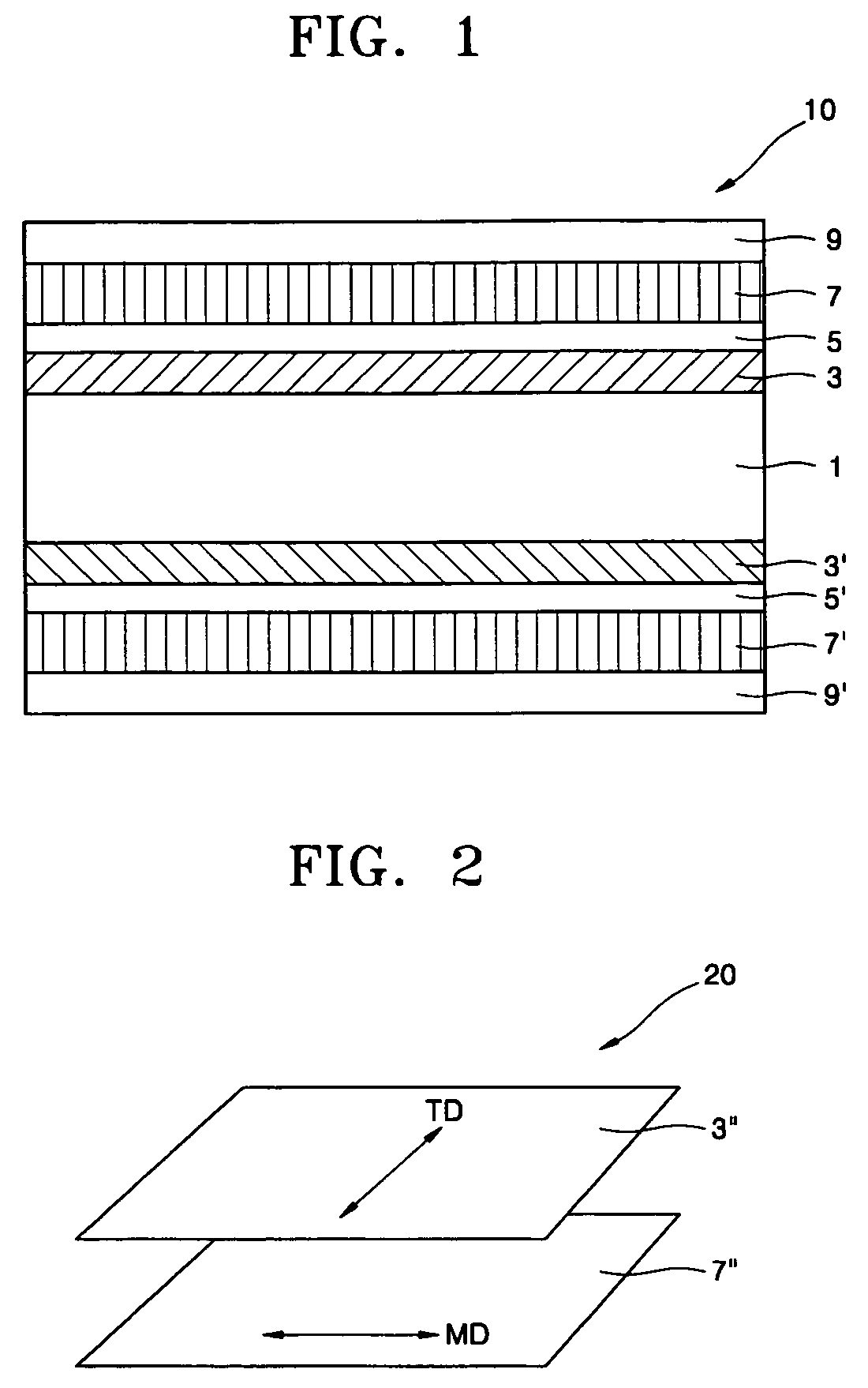Biaxial-optical polynorbornene-based film and method of manufacturing the same, integrated optical compensation polarizer having the film and method of manufacturing the polarizer, and liquid crystal display panel containing the film and/or polarizer
a technology of optical phase retardation and polynorbornene, which is applied in the direction of instruments, other domestic objects, transportation and packaging, etc., can solve the problems of inability to control the retardation value in a thickness direction through secondary film processing, poor thermal stability and oxidative stability, and inherent optical anisotropy, so as to improve the efficiency of compensating optical phase retardation due to the birefringence of the liquid crystal layer, the effect of increasing the range of the retardation valu
- Summary
- Abstract
- Description
- Claims
- Application Information
AI Technical Summary
Benefits of technology
Problems solved by technology
Method used
Image
Examples
example 1
[0091]A butyl norbornene / 5-norbornene-2-carboxylic acid butyl ester (molar ratio: 5 / 5) copolymer (PBu5-Be5 NB) was dissolved in a solvent system composed of methylene chloride (b.p. 39.8-40° C.) and cyclohexanone (b.p. 155.6° C.) in a weight ratio of 98:2 to obtain 18 wt % of a polymer solution. This solution was cast on a mirror polished steel sheet and partially dried at 30° C. for 1 hr. The resulting film was peeled from the steel sheet and partially dried again at 100° C. for 1.5 min. The thickness of the film and the content of solids were measured. As a result, the thickness of the film was about 105 μm and the content of solids was about 95.8%.
[0092]The film was uniaxially stretched using a clip-type grip at a stretching ratio of 1.4 folds at 75° C. The film was heated to 160° C. within 10 min while maintaining the stretching ratio and dried at the same temperature for 10 min. Next, the film was cooled to 70° C. and maintained at the same temperature for 2 min, and then tensi...
example 2
[0093]A butyl norbornene / 5-norbornene-2-carboxylic acid butyl ester (molar ratio: 5 / 5) copolymer (PBu5-Be5 NB) was dissolved in a solvent system composed of toluene (b.p. 110.6° C.) and cyclohexanone (b.p. 155.6° C.) in a weight ratio of 97:3 to obtain 20 wt % of a polymer solution. This solution was cast on a mirror polished steel sheet and partially dried at room temperature for 1.5 hr. The resulting film was peeled from the steel sheet and partially dried again at 100° C. for 4 min. The thickness of the film and the content of solids were measured. As a result, the thickness of the film was about 108 μm and the content of solids was about 95.5%.
[0094]The film was uniaxially stretched using a clip-type grip, as used in Example 1, at a stretching ratio of 1.4 folds at 70° C. The film was heated to 160° C. within 10 min while maintaining the stretching ratio and dried at the same temperature for 10 min. Next, the film was cooled to 70° C. and maintained at the same temperature for 2...
example 3
[0095]A 5-norbornene-2-allylacetate / 5-norbornene-2-carboxylic acid methyl ester (molar ratio: 7 / 3) copolymer (PAa7-Me3 NB) was dissolved in a solvent system composed of toluene (b.p. 110.6° C.) and cyclohexanone (b.p. 155.6° C.) in a weight ratio of 97:3 to obtain 20 wt % of a polymer solution. This solution was cast on a mirror polished steel sheet and partially dried at room temperature for 1.5 hr. The resulting film was peeled from the steel sheet and partially dried again at 100° C. for 8 min. The thickness of the film and the content of solids were measured. As a result, the thickness of the film was about 110 μm and the content of solids was about 96.0%.
[0096]The film was uniaxially stretched using a clip-type grip, as used in Example 1, at a stretching ratio of 1.2 folds at 90° C. The film was heated to 190° C. within 10 min while maintaining the stretching ratio and dried at the same temperature for 10 min. Next, the film was cooled to 70° C. and maintained at the same tempe...
PUM
| Property | Measurement | Unit |
|---|---|---|
| glass transition temperature | aaaaa | aaaaa |
| glass transition temperature | aaaaa | aaaaa |
| glass transition temperature | aaaaa | aaaaa |
Abstract
Description
Claims
Application Information
 Login to View More
Login to View More - R&D
- Intellectual Property
- Life Sciences
- Materials
- Tech Scout
- Unparalleled Data Quality
- Higher Quality Content
- 60% Fewer Hallucinations
Browse by: Latest US Patents, China's latest patents, Technical Efficacy Thesaurus, Application Domain, Technology Topic, Popular Technical Reports.
© 2025 PatSnap. All rights reserved.Legal|Privacy policy|Modern Slavery Act Transparency Statement|Sitemap|About US| Contact US: help@patsnap.com



